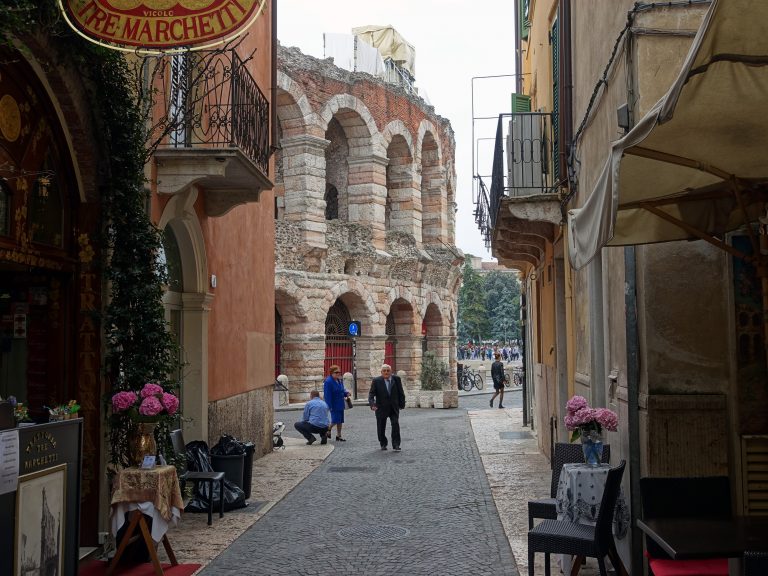 For a city of around 275,000 inhabitants, Verona can swell twice it’s size between June and September, most of t come for the Summer Opera Season at the Verona Arena or to see the (fictional) home of Juliet Capulet.
For a city of around 275,000 inhabitants, Verona can swell twice it’s size between June and September, most of t come for the Summer Opera Season at the Verona Arena or to see the (fictional) home of Juliet Capulet.
In between these two big draws there is an amazing UNESCO World Heritage City filled with ancient Roman Ruins, Medieval Castle Fortresses, Ancient City Walls, Gothic and Romanesque Churches and beautiful 14th-16th century Piazze. There is a lot packed into this small city.
Thanks to the strategic location on the Adige River and the fertile Po River Valley, Verona has enjoyed a prosperous life since around 500 BC. It became a Roman colony is 89 BC. In 49 BC all Veronese were granted Roman citizenship by Julius Caesar who used to vacation here himself.
By the end of the 1st century, Verona had a population of over 25,000, a city wall with large gates, Roman Forts, a Forum, wealthy villas, a theater and a large amphitheater that held 30,000.
Ancient Verona was also well situated between three important Roman roads; the via Postumia (built in 148 BC) that traveled from Genoa to Aquileia in Friuli, the Via Claudia Augusta (built in 47 AD) that traveled from the Po River Valley through the Alps into southern Germany) and the Via Gallica that went from the Po River valley to Brescia, Bergamo, the Lakes and Milan. It’s no wonder why Verona became a hub for ground and naval transportation and the defense of the northern Empire against Gallic and Celtic tribes.
VERONA AMPHITHEATER
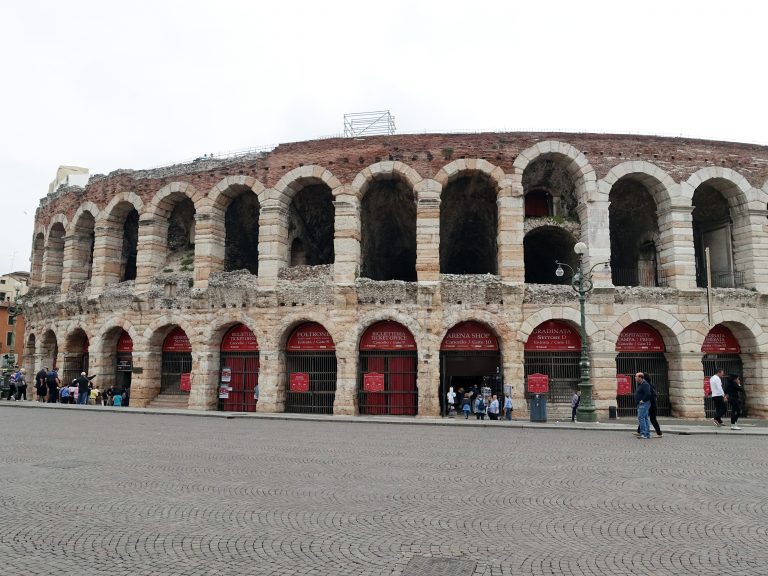 The Verona Arena is the most famous of the ancient treasures here. It’s the 2nd most complete amphitheater in Italy (the Coliseum in Rome is #1). During the span of the Roman Empire over 230 amphitheaters were built. The best survivors are in Rome (Italy), Arles (France), Nimes (France), El Djem (Tunisia), Pula (Croatia) and here in Verona.
The Verona Arena is the most famous of the ancient treasures here. It’s the 2nd most complete amphitheater in Italy (the Coliseum in Rome is #1). During the span of the Roman Empire over 230 amphitheaters were built. The best survivors are in Rome (Italy), Arles (France), Nimes (France), El Djem (Tunisia), Pula (Croatia) and here in Verona.
The Arena was built in the 1st century. Some attribute it to the reign of Tiberius, around 30 AD, while others say it was later, around 75 AD, during the reign of Vespasian. The Coliseum in Rome and the Amphitheater of Pula (Croatia) were also built during the time of Vespasian so it kind of makes sense that the Verona Arena was built at the same time.
The original Amphitheater was built at 152m x 113m (498’ x 371’) but after an earthquake in 1117 collapsed parts of the outer ring and the subsequent dismantling of stones by local scavengers, the overall size was reduced down to 140m x 110m (459’ x 361’), although when the Venetians took the city in 1405 they restored a lot of the outer wall.
Most of the interior shape is still in tact but the outer ring known as the ‘Aula’ or wing is mostly gone. It’s still very big and with 45 tiers of steps, there is plenty of room to stage a grand Opera performance, which has been happening every year since 1913.
Over 30,000 spectators watched gladiatorial games here till 404, when the Western Roman Emperor Honorius ended the entertainment of mortal combat. By the way, he ended this spectacle of death over 50 years after the Roman Empire became a Christian Empire. I guess back then the early Christians still enjoyed a good blood sport.
When the Goths took the city in 489, they used it for festivals and entertainment. The Goths were Christian but we have no evidence of mortal combat games reinstated in the Amphitheater.
During the Middle Ages, executions were added to the list of events held in the Arena. One of the worst occurred during the 13th century when 166 Cathars were burned alive.
Cathars were Christians who believed the mortal world was created by Satan and only the belief in the “good” god would save our everlasting souls. Pope Innocent III believed the Cathars should be wiped from the face of the earth. The slaughter of Cathars through France and Italy was one of the worst tragedies ever committed in the name of Christianity. In Béziers France alone, 20,000 Cathars were slaughtered.
I’ve written more about the Cathars in my post from the Languedoc in 2004.
In 1889, William ‘Buffalo Bill’ Cody and his Wild West Show featuring Annie Oakley performed inside the Verona Arena
On August 10, 1913, Verdi’s Aida was performed in the ‘Arena’ as a tribute to the 100th anniversary of Verdi’s birth and with the exception of war years (1915-1918 and 1940- 1945) there has been a summer (June through August) Opera season here for over 100 years.
The Arena seats 15,000 for each production, half of what the original audience was in the 1st century. Tickets range from to sit on the hard stone bleachers in the nosebleed section to for the nice padded seats on the Arena floor.
You can book your tickets at the Arena website.
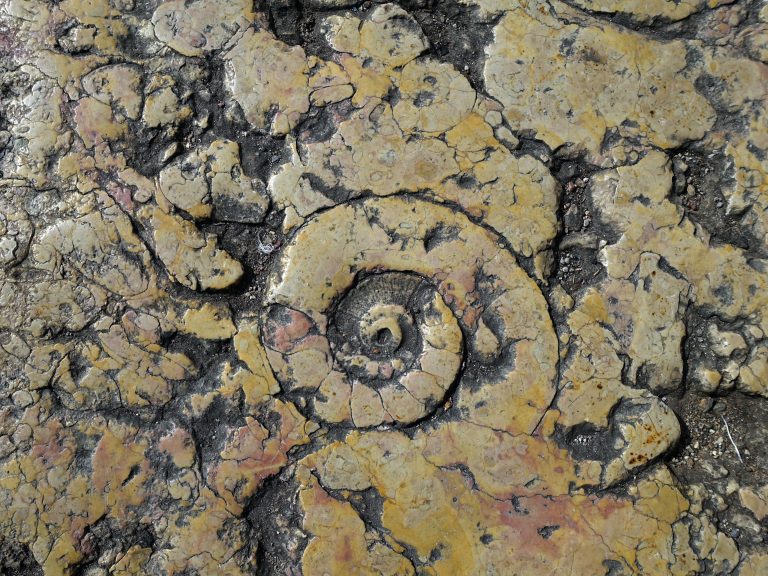 The Verona Arena is mostly constructed of pink and white Jurassic age limestone quarried from nearby Sant’Ambrosia di Valpolicella, about 10 miles north of Verona in a hilly area near Lake Garda mostly known for it’s wines.
The Verona Arena is mostly constructed of pink and white Jurassic age limestone quarried from nearby Sant’Ambrosia di Valpolicella, about 10 miles north of Verona in a hilly area near Lake Garda mostly known for it’s wines.
If you walk across the limestone tiers of seating and look carefully you’ll see the coiled mollusk shapes in the stone. Although they might look like the modern nautilus shell, they are actually another species known as ‘ammonites’, more closely related to an octopus or squid than a nautilus and NOT related to the Ammonites who were a pre biblical Semitic people from the Jordan River valley. Whatever these organisms were related to, they went extinct in the Cretaceous period at the same time as the dinosaurs, over 100 millions years ago.
The name comes from Pliny the Elder who coined them ‘Ammonus Cornua’ in the 1st century when he first noticed them and though they looked like the rams horns worn by the Egyptian god Ammon. Pliny the elder died in 79 AD when he decided to get closer to the volcanic eruption of Mount Vesuvius that destroyed Pompeii and also destroyed Pliny the elder.
The tiers of the Verona Arena are filled with ammonite mollusk fossils, creating wonderful spiral designs in the pink and yellow stone.
Once you see them inside the Arena, you can’t help noticing them all over Verona’s streets.
THE GATES AND TO THE ANCIENT ROMAN CITY
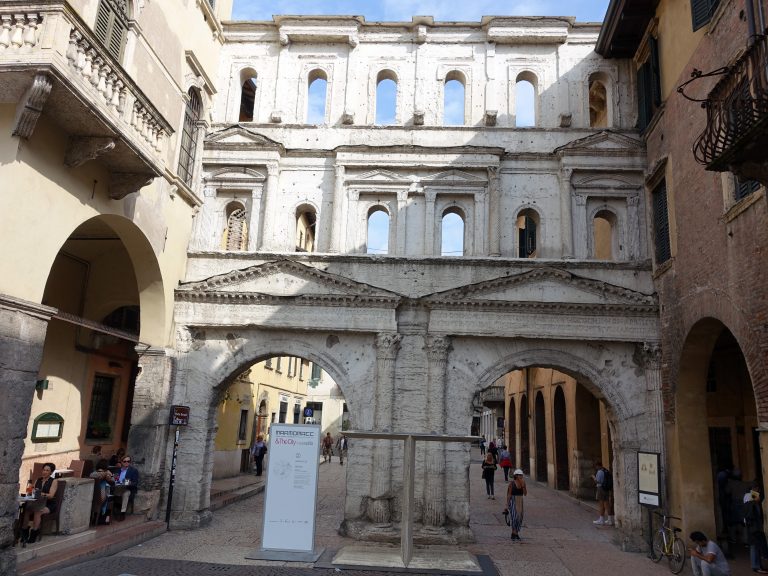 The white limestone 1st century Porta Borsari (Porta Iovia) was the main entrance to the Roman city from the via Postumia. There is still an inscription on the gate from the time the Emperor Gallienus made renovations in 265.
The white limestone 1st century Porta Borsari (Porta Iovia) was the main entrance to the Roman city from the via Postumia. There is still an inscription on the gate from the time the Emperor Gallienus made renovations in 265.
The via Postumia became the Decumanus Maximus in the city. Roman cities had two main arteries of traffic: the Decumanus (east to west) and the Cardus (north to south). The Decumanus Maximus also led to the Military Fort, which in Verona was by way of the two Roman bridges across the Adige River.
The name Borsari comes from the middle ages when the gate was used to collect tolls and customs duty on merchandise coming in and out of the gate. The bags the customs agents filled with money are ‘bores’ and the agents themselves were called the Borsari.
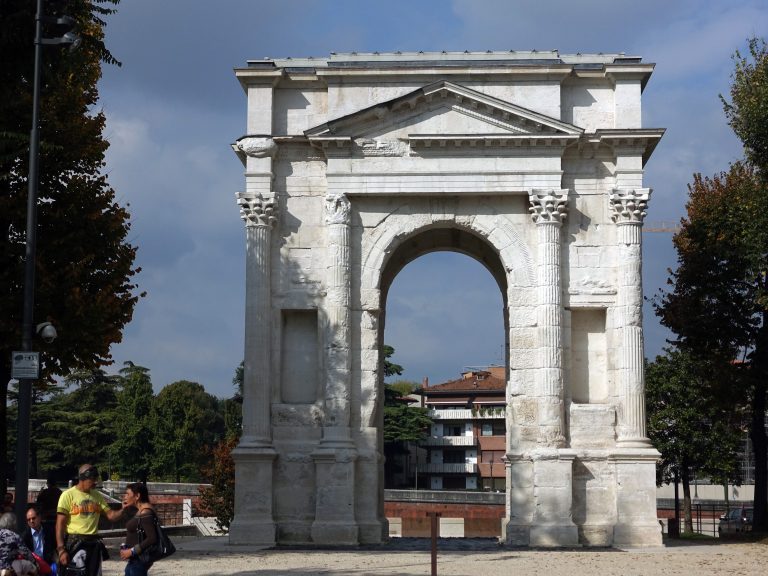 The 1st century Arco dei Gavi, a memorial arch built by the Gavi family, is also on the via Postumia, (the Decumanus). Most of the arches built during the Roman Empire were in honor of the Emperor but there are a few excellent examples of wealthy family building arches in honor and memory of their family. If you’re ever in Pula, Croatia, check out the Arch of the Sergii built by the Sergii family. Pula also has one of the best Roman Amphitheaters in the world.
The 1st century Arco dei Gavi, a memorial arch built by the Gavi family, is also on the via Postumia, (the Decumanus). Most of the arches built during the Roman Empire were in honor of the Emperor but there are a few excellent examples of wealthy family building arches in honor and memory of their family. If you’re ever in Pula, Croatia, check out the Arch of the Sergii built by the Sergii family. Pula also has one of the best Roman Amphitheaters in the world.
During the middle ages the Gavi Arch was in
corporated into the expanded city walls and used as one of the main gates till it was demolished in 1805 during the Napoleonic occupation. In 1932, most of the pieces were found and the arch was resurrected next to the Scalageri Fortress known as ‘Castelvecchio’. It’s current location is very close to the original one. The Gavi Arch still has the inscription of the architect, Lucius Vitruvius Cordo who worked a lot in ancient Verona. The inscription reads: Lucius Vitrivius Cerdo, a freedman of Lucius.
The Porta Leoni is the oldest gate in Verona, from around 50 BC. The name Leoni comes from a Roman tomb decorated with two lions found nearby. Not much is known about the Porta Leoni prior to the middle ages and not much of the gate is left. It was once a double façade with two towers but now only half of the inner façade is visible. The other half is long gone, probably used as building materials. In fact, the Porta Leoni actually looks like building materials used to hold up the corner of the intersection at via Amanti and via Leoni.
BRIDGES TO THE ANCIENT ROMAN CITY
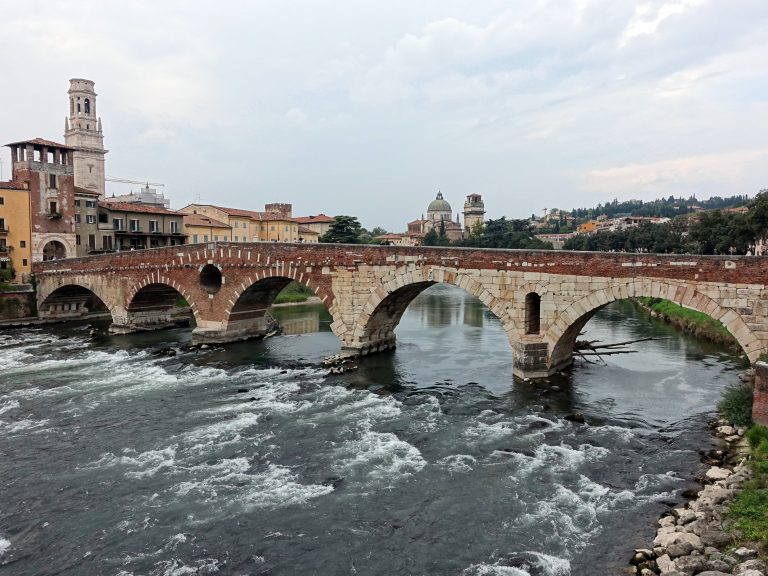 The Ponte Pietra (Stone Bridge) is the ancient Roman Pons Marmoreus was also built on the Via Postumia in 100 BC. During the Roman times, there two bridges (the Marmoreus and the Postumius ) flanking each other across the Adige River. By the 10th century, The Postumius Bridge was pretty badly damaged. The floods of 1154 and 1239 wiped out any remaining parts of the bridge.
The Ponte Pietra (Stone Bridge) is the ancient Roman Pons Marmoreus was also built on the Via Postumia in 100 BC. During the Roman times, there two bridges (the Marmoreus and the Postumius ) flanking each other across the Adige River. By the 10th century, The Postumius Bridge was pretty badly damaged. The floods of 1154 and 1239 wiped out any remaining parts of the bridge.
According to the Italian archeology writer Vittorio Galliazzo, there are still remains of 900 ancient Roman bridges throughout Europe, Turkey, Middle East and northern Africa.
Actually, only the first two arcades on the left side of the bridge are from the Roman period. The other three were rebuilt.
The one closest the right bank was built by Alberto I della Scala in 1298. The other two were built in the 16th century. The difference between the arches is pretty obvious. The newer arches are the traditional red brick look favored by the Della Scala (Scalageri) family.
The Torre di Guardia (Watch Tower) on the right bank was also built by Alberto I della Scala at the same time he repaired the bridge.
On April 24, 1945, the four center sections of the span were blown up by the retreating German Army. However, the Superintendent of Monuments had an idea the war might damage some of the monuments and so he had a team of people photograph every detail of the bridge. After the war, the Ponte Pietra was restored, rebuilt to the exact details with the same materials.
THERE ONCE WAS A ROMAN FORUM UNDER THE PIAZZA DELLE ERBE
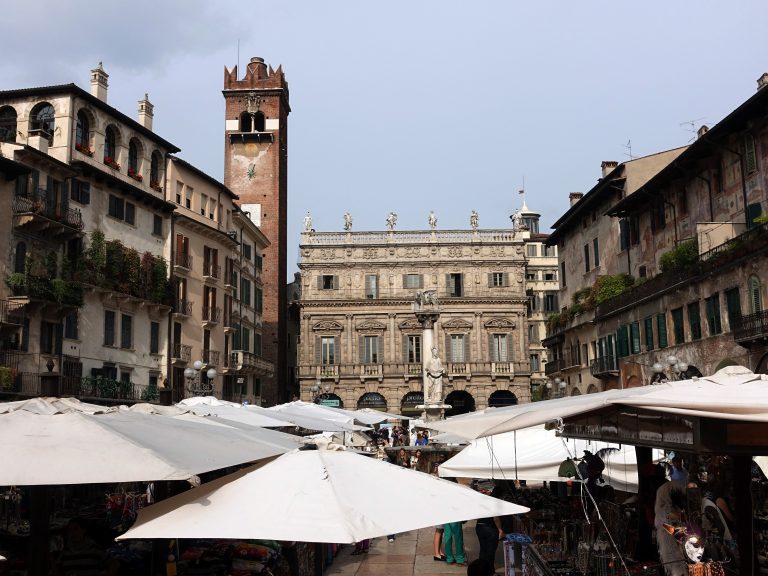 The Piazza delle Erbe and the sits on what was once the ancient Roman Forum but what is under the Piazza might remain untouched. The 12th – 16th century Piazza is so beautiful and historic in it’s own right that archeological digs under them seems absurd.
The Piazza delle Erbe and the sits on what was once the ancient Roman Forum but what is under the Piazza might remain untouched. The 12th – 16th century Piazza is so beautiful and historic in it’s own right that archeological digs under them seems absurd.
The Pizza is named after the herbs and vegetables that were once sold here. This has always been the hub of commerce and life.
There is a curious covered square pavilion in the center of the square with handcuff chained to the upright post. I have no idea why it’s there but my guess is for tourist imaginations. I have never read anything about public executions or criminals put on display in the center of the square.
The fountain in the center of the square was built in 1368 by Cansignorio della Scala. . The statue on top of the fountain is called Madonna Verona, but it’s ancient Roman from 380 ad.
The statue faces the 16th century Loggia Berlina where political critics were once tied up and pelted with rotten vegetables sold in the market square.
The 12th Century Scalageri Palace was once located in the square but the Della Scala family had many palaces, including the Great Scalageri Fortress known as Castelvecchio. The Palace went through many renovations and became the Casa Mazzanti. The only accessible part of the old Palazzo is at the Café at Casa Mazzanti, a good spot for a coffee or cocktail.
The Hall of Commerce (Palazzo Maffei) is a Baroque masterpiece crowned with statues of Hercules, Venus, Jupiter, Minerva, Mercury and Apollo.
The 14th century Gardello Tower was built by Cansignorio della Scala. The clock and moving spheres were added in 1421 when it became known as the Torre delle Ore (Tower of Hours), or the clock tower. You can see the original bells in the Castelvecchio Museum.
The Piazza dei Signori, around the corner might also have been built over the Roman Forum. This is the royal square where the Scalageri Palaces once ruled the city. In the center of the square is a 17th century statue of Dante who was supported by of Cansignorio.
The square is filled with 12th-15th century buildings ranging from the Palazzo della Ragione (Town Hall), the Casa dei Mercanti (Merchants Hall and now the Banca Popolare di Verona), the Podesta (government Palace) and the Consignorio Scalageri Palace.
There is a mouth under the 17th century entrance known as the Porta dei Bombardieri (the gate of artillerymen) on the Cansgnorio Palace where people used to feed anonymous complaints against their neighbors, ratting them out to the local authorities.
THE ROMAN THEATER
The Roman theater sits at the base of the hill next to the Scalageri Castelvecchio. It’s one of the most preserved 1st century Roman Theaters in Italy. The first theater here dates back to the 1st century BC at the time of Augustus.
The theater was buried under the complex of churches, convents and urban construction for years until 1757 when excavations were made to recover it. In 1830 many of the houses on the hill were removed and through further excavations in the early 1900s, the theater gradually came back to life. The restoration was completed in 1955. The original theater was around 400’ x 500’. The current version is reduced down to around 350’ x 450’.
The cavea (horseshoe shaped seating tiers) are pretty much all that remains but they’re in good condition. There are also some original steps, the remains of a few arches and part of the ancient stage. The theater is used for small ballet, small concerts and, of course, dramatic performances. When the performance season ends (the same time as the Opera season) the Theater often closes for reparations.
Above the theater, on what was once called the Mons Gallus, is the Castel San Pietro. It was inhabited by Theodoric the Great in the 5th century and later used and added onto by Pepin the short in the 8th century and Berengar I in the 9th century. Gian Galeazzo Visconti, the Duke of Milan built a Castel here in 1398 but it was blown up by Napoleon’s French in 1801. The Austrians built the current Castel up on the hill in 1856. It’s a great view over the city but the Castel has been closed for a long time. There are plans to turn it into a museum but you know how plans go.
ROMEO AND JULIET TOURISM
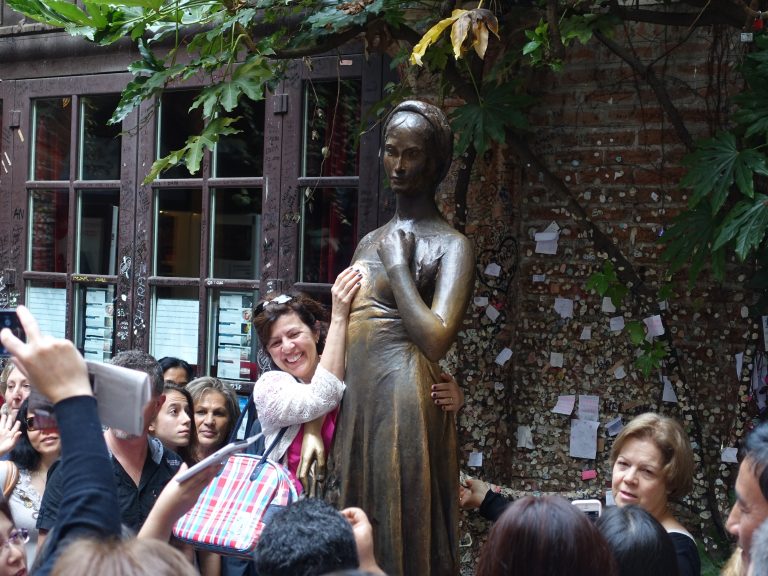 We’re staying at the Escalus Verona, a small hotel a stone’s throw from the Verona Arena. Escalus was the Prince in Shakespeare’s ‘Romeo and Juliet’. He is the voice of reason a calm who tries to keep the Montague and Capulet families in peaceful coexistence. The hotel is built from an old building and although the exterior is fairly nondescript, the rooms are large and contemporary and the staff is wonderful. We are in the attic room which can be a head bumper for taller people but it does have the added attraction of an amazing private terrace overlooking the Arena. We sat up on the terrace and listened to a performance of Jesus Christ Superstar.
We’re staying at the Escalus Verona, a small hotel a stone’s throw from the Verona Arena. Escalus was the Prince in Shakespeare’s ‘Romeo and Juliet’. He is the voice of reason a calm who tries to keep the Montague and Capulet families in peaceful coexistence. The hotel is built from an old building and although the exterior is fairly nondescript, the rooms are large and contemporary and the staff is wonderful. We are in the attic room which can be a head bumper for taller people but it does have the added attraction of an amazing private terrace overlooking the Arena. We sat up on the terrace and listened to a performance of Jesus Christ Superstar.
Shakespeare took his story from the 1562 poem the ‘Tragicall Historye of Romeus and Juliet’ by Arthur Brooke.
Brooke took the story from an Italian novella written by Matteo Bandello, a novelist from Mantua who wrote the book around 1560. Bandello’s stories were also the inspiration for ‘Twelfth Night’ and ‘Much ado about Nothing’.
Matteo Bandello took the story from a novella written in 1531 by Luigi da Porto, a captain in the Venetian Republic army who heard the story from one of his bowmen. Every story has a story.
I had an High School English teacher who told us that Shakespeare never traveled outside of England. He got all his ideas from books. In the 16th century England, Italians were considered clever, devious and exotic and of the 37 plays Shakespeare wrote, 14 of them take place in Italy.
Most literary historians believe the feuding families of the Montague and Capulet were modeled after the Montecchi and Cappelletti but in the 14th century these names were more known as political factions representing the Guelph and Ghibellines (more about this feud in a minute).
The Montecchi were originally from Vicenza, a good 50 kilometers from Verona. The Cappeletti (named for the linen hats they wore) were centered in Cremona, 100 kilometers away, but why let the facts get in the way of a good story. Actually there were members of each political family who settled within the city of Verona.
The last of the Montecchi family, Crescimbene de Monticuli, was thrown out of Verona in 1324 by Cangrande I (Scalageri). The house where the Monticuli (supposedly) lived is on the Via delle Arche Scalageri. It is now known as the house of Cagnolo Nogarola called Romeo’s house (Casa di Cagnolo Nogarola detto Romeo).
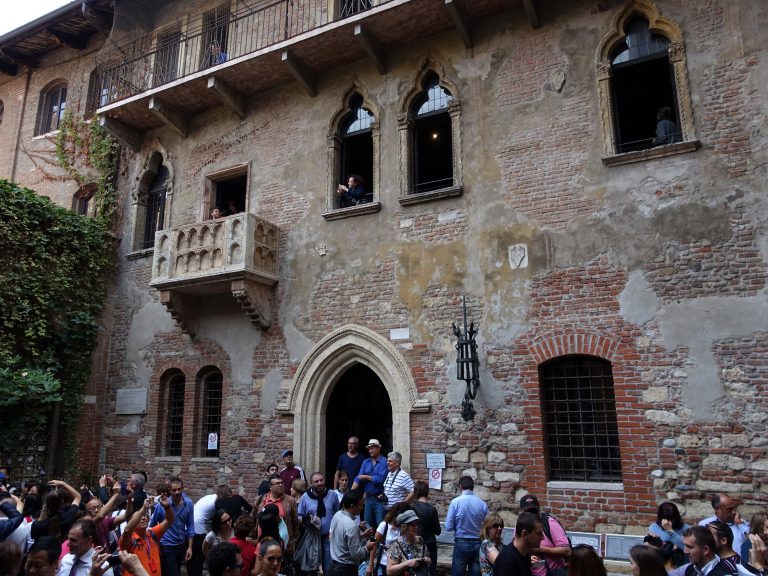 The house did actually belong to the Cagnolo Nogarola family (part of the della Scala family). The only way you’ll know it’s Romeo’s house is from the plaque on the wall. The house is private and tourists are not allowed inside. The house, by the way, is conveniently close to Juliet’s house.
The house did actually belong to the Cagnolo Nogarola family (part of the della Scala family). The only way you’ll know it’s Romeo’s house is from the plaque on the wall. The house is private and tourists are not allowed inside. The house, by the way, is conveniently close to Juliet’s house.
The house that poses as Juliet’s house was once owned by the dal Cappello family. In fact the house sits on the via Cappello. It’s very close to Romeo’s house and very very close to the crowded Piazza delle Erbe.
There are Romeo and Juliet references all over Verona, but Juliet’s house and the balcony where she gazed down to Romeo’s sweet words is the one that tourists flock to.
Juliet never lived in the house. Yes, that’s right Virginia, there never really was a Juliet Capulet. She is a work of fiction but that doesn’t get in the way of the faithful.
Inside the Capulet Museum is filled with movie and photo trivia about the play. There is also a computer room where you can send love letters to your favorite character.
The Capulet house does date back to the 14th century, which was the period when the play takes place, but the famous balcony was added much later in order to tie into the story. The balcony is actually a medieval sarcophagus attached to the wall over the courtyard. If you didn’t know, you’d never notice.
Not much is known about the Cappello family except they sold the property to the Rissardi family in 1667. The Rissardi opened it as a hotel and, of course, told the guests the house was once the home of Shakespeare’s Juliet. It was sold to the state in 1905 and was pretty much forgotten.
In 1936, George Cukor’s film of Romeo and Juliet changed everything. The film starring Norma Shearer and Leslie Howard became an international sensation and by 1939, Juliet mania was in full swing. September 16th has been deemed Juliet’s birthday. I have no idea why but it has become a very big day for Juliet tourism.
For many years unrequited lovers have attached notes or graffiti to the brick walls of the courtyard under the balcony, hoping that the fictitious romantic heroine would somehow create a magic spell that will grant them their true love’s request.
The adhesive of choice for posting notes was chewing gum. It got pretty ugly. In 2012 the city of Verona had enough and passed an ordinance against chewing gum or graffiti on the walls with a penalty up to a 500 euro fine. The gum law was originally passed in 2004 but I guess it didn’t stick and so now it’s being re-enforced.
These days romantic tourists are still allowed to leave their love letters to Juliet but only on the removable panels in the entrance arch to the courtyard. Romeo and Juliet tourism is enormous and the city legislators are very careful not to piss off the visitors too much.
Fictional tourism is big business. One of the favorite tourism destinations in London is the Sherlock Holmes apartment at 221B Baker Street.
Ever since the fall of the Soviet Union thousands have made the visit to Dracula’s Castle (Bran Castle in Romania) which by the way is currently for sale.
In my city of San Francisco, where the Sam Spade walking tour is very popular, you can go to a small alley called Burritt Street, just off Bush Street above the Stockton Tunnel near Union Square. There is a plaque on the wall that reads, ‘On approximately this spot Miles Archer, partner of Sam Spade, was done in by Brigid O’Shaughnessy.’
Aside from the visitors to the house, over 6,000 letters addressed to ‘Juliet’s House’ Verona Italy arrive every year.
They are mostly received by the Juliet Club, a group who share the courtyard with the famous Juliet House. This is a volunteer organization of people 18 or over preferably with candidates who have several languages and a background in psychology, sociology, literature and journalism. Not all candidates are accepted.
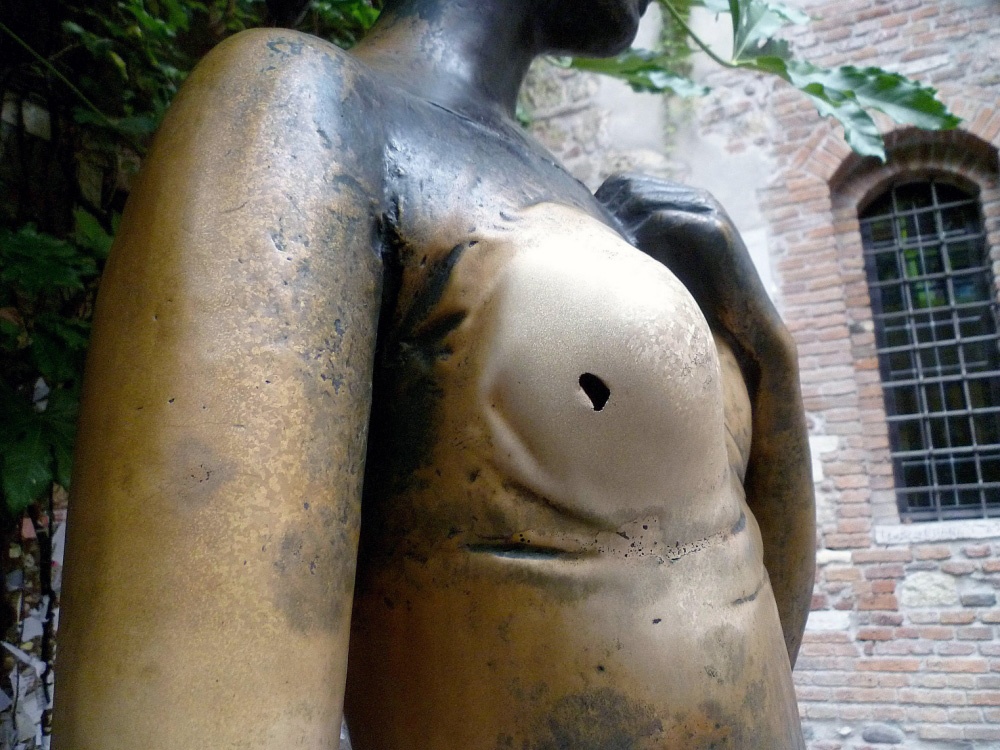 There used to be another way to have your love granted that didn’t require writing a note. There was a bronze statue of Juliet in the courtyard and just a rub of her right breast would grant you the fulfillment of your true love. That was until early 2014 when the statue was removed. The statue was put there in 1972 but after 42 years of aggressive groping and rubbing, the breast developed a large hole and the right arm used to support the gropers of the magic orb cracked. The statue is being restored in the Museum Castelvecchio. The right arm and right breast of the replacement statue are already showing the polished acid touch of human hands.
There used to be another way to have your love granted that didn’t require writing a note. There was a bronze statue of Juliet in the courtyard and just a rub of her right breast would grant you the fulfillment of your true love. That was until early 2014 when the statue was removed. The statue was put there in 1972 but after 42 years of aggressive groping and rubbing, the breast developed a large hole and the right arm used to support the gropers of the magic orb cracked. The statue is being restored in the Museum Castelvecchio. The right arm and right breast of the replacement statue are already showing the polished acid touch of human hands.
If you are serious in your quest for everything Romeo and Juliet in Verona, there are a few other locations you might want to visit.
Juliet’s tomb is in the crypt of the Convent at the San Francesco al Corso Church. This Franciscan church has been here since the 13th century and since it was outside the Verona city walls in the 14th century it fit the description for the burial of Juliet. The convent also has a medieval museum and fresco museum.
The crypt of the 11th century basilica of Saint Zeno is now regarded as the place where Romeo and Juliet were married by Friar Lawrence. The crypt is eternally occupied by the relics of Saint Zeno, the 8th bishop of Verona and the city’s patron Saint.
Zeno was born in Mauretainia (northern Africa) around 300. According to Saint Ambrose (of Milan) who lived at the same time, Zeno died a ‘happy Death’ and was not tortured or martyred. However, according to Catholic mythology, if you are a saint you had to be martyred and so according to the Roman Martyrology, the Bishop of Verona was martyred by the Emperor Gallienus in 371 AD, even though the Emperor Gallienus died in 268.
According to legend, Theodoric the Great consecrated a small church over the tomb of Zeno in the late 4th century. In the 9th century his bones were moved to a new basilica built over the ancient Roman road, the Via Gallica. They were moved again during the Magyars invasion of the early 10th century and then moved back again on May 21st 921. Even though the feast day of Saint Zeno is actually April 12th, the Veronese celebrate on May 21 to coincide with the reburial of the sacred bones, the same bones that share the crypt where Romeo and Juliet were secretly married.
Theodoric the Great rebuilt the fortifications of the city but eventually lost the city to the Lombards. The Lombards finally fell to Charlemagne in 774.
By the way, Bell ringing began here in Verona in 622 when bells in the tower rang to announce the death of the Bishop Mauro. The earliest grand bell tower was at the Basilica di San Zeno in 1149.
THE GUELPH, GHIBELLINES AND THE SCALAGERI
 Let’s backtrack a few minutes here for a brief introduction to the Italian City/States of the 11th-14th centuries, a time of feuding wealthy families preying on other wealthy families who lived nearby all in the name of the Guelph and Ghibellines. Lombardy and the Veneto is still filled with the fortresses and towers of the Visconti, Sforza, Malatesta, Gonzaga, d’Este, da Romano, Scalageri and others.
Let’s backtrack a few minutes here for a brief introduction to the Italian City/States of the 11th-14th centuries, a time of feuding wealthy families preying on other wealthy families who lived nearby all in the name of the Guelph and Ghibellines. Lombardy and the Veneto is still filled with the fortresses and towers of the Visconti, Sforza, Malatesta, Gonzaga, d’Este, da Romano, Scalageri and others.
The age old rivalry between the Houses of Bavaria and Swabia moved into Italy after Frederick II (Barbarosa) was crowned Holy Roman Emperor in 1152. His resistance was Pope Alexander III.
The Pope was supported by the Guelphs (from the Bavarian ‘Welfs’), merchant families of the larger cities. The Emperor was supported by the Ghibellines (from Waiblingen, the ancestral home of the Hohenstaufen Swabians), land owners of the smaller cities. The conflict, mostly in Northern Italy, lasted over 400 years.
By the way, the great Emperor Frederick II Barbarosa who started the mess drowned in 1190 while crossing a shallow part of the Saleph River in Turkey (now known as the Göksu River). The current was too strong and the horse dumped the Emperor into the water face down. The water was shallow but the armor was too heavy and he couldn’t roll over. His troops packed him in a vat of vinegar, hoping to preserve him for a burial in Jerusalem but it didn’t work. His remains made it as far as Antioch (modern day Antakya) in southern Turkey.
It was the da Romano family that secured Verona for the Ghibellines after Ezzelino II da Romano defeated the ‘Lombard League’ of Pope supporters in 1212. His son Ezzelino III has gone down in history as one of the cruelest tyrants of Italian history. By the 14th century, historians claimed he was the ‘Son of Satan’. Even Dante placed him in the 7th circle of Hell. However, history always seems to be rewritten by the victorious.
When Ezzelino III died in 1259, the Scaligeri family took control of Verona. The family emblem is the ladder (Scala) but the family identified more with a pack of wild dogs.
The first ruler was Mastino I (Mastiff I). Down the line came Cangrande I (Big Dog I), Mastino II (Mastiff II), Cangrande II (Big Dog II) also known as Can Rabbioso (Rabid Dog), Cansignorio (Lord Dog) and Can Francesco (Dog Frank). Rabid dog was killed by Lord Dog in 1359.
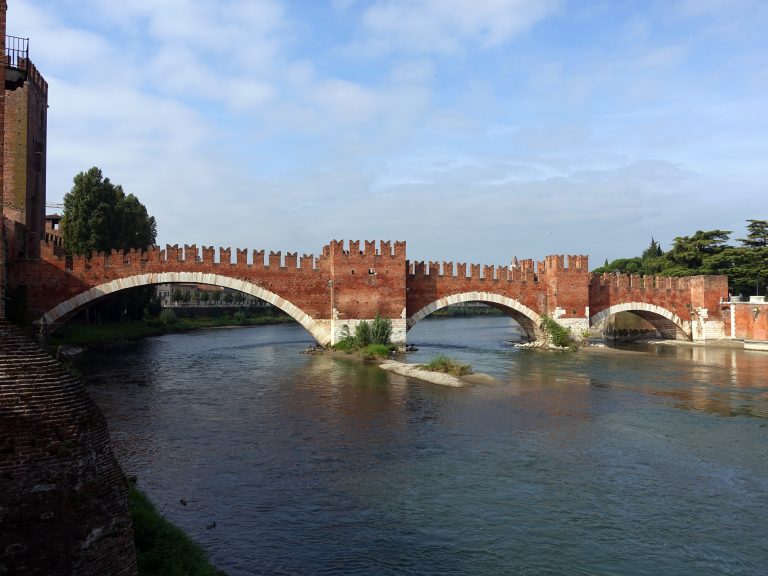 Castelvecchio and the beautiful brick Castelvecchio Bridge were built by Cangrande II (Can Rabbioso) to protect himself from his enemies (the Venicians, the Sforza of Milan and Gonzaga of Mantua. Unfortunately the enemy who managed to kill him in 1359 was his brother Cansignorio who gave the city some of it’s most memorable 14th century buildings; the palaces in the Piazza dei Signoria, the Scalageri Tombs and the Gardello watchtower which in 1370 was built with a 51” wide 4,000 pound cast bell and one of the first bells to strike the hours in the world. This bell is in now the Castelvecchio Museum.
Castelvecchio and the beautiful brick Castelvecchio Bridge were built by Cangrande II (Can Rabbioso) to protect himself from his enemies (the Venicians, the Sforza of Milan and Gonzaga of Mantua. Unfortunately the enemy who managed to kill him in 1359 was his brother Cansignorio who gave the city some of it’s most memorable 14th century buildings; the palaces in the Piazza dei Signoria, the Scalageri Tombs and the Gardello watchtower which in 1370 was built with a 51” wide 4,000 pound cast bell and one of the first bells to strike the hours in the world. This bell is in now the Castelvecchio Museum.
Construction of Castelvecchio started in 1354 over an ancient Roman Fort on other opposite side of the Adige River. It’s a great example of Gothic Castle construction and now, mostly used as the Medieval museum.
The Ponte Scaligero, the fortified brick and concrete bridge across the Adige River was also built in the 1350’s. It is an extention of the fortifications of the Castle. At it’s time of completion, it was the longest span bridge in the known world, 48.7 m (159.8 feet).
The designer, Guglielmo Bevilacqua was so nervous about the construction, he came to the inauguration of the bridge on horseback, just in case he needed to make a fast getaway if the bridge collapsed. The bridge worked out perfectly, that was until it was completely destroyed by the retreating Germans on April 24, 1945. The reconstruction (minus one of the fortified towers) began in 1949. I don’t know why they never built the second tower. Maybe they ran out of funding. Anyway, the bridge reopened in 1951.
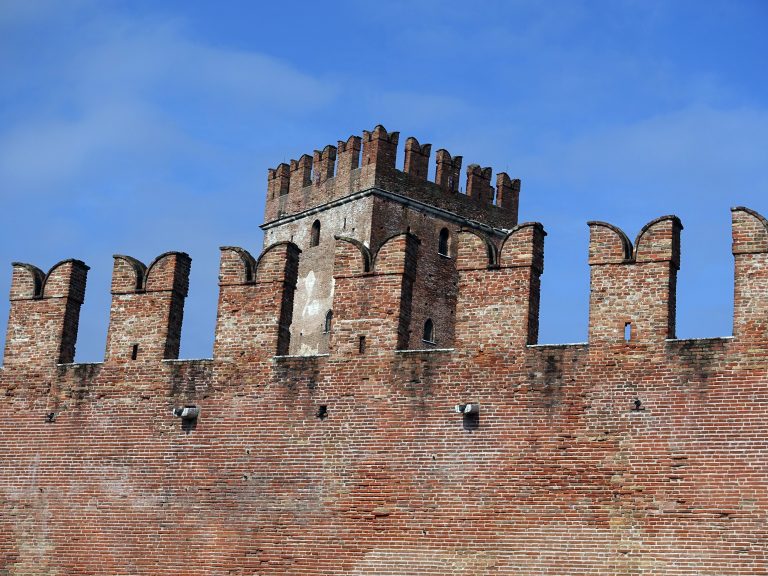 The Mastio Tower is the centerpiece. It was the lookout guard tower that protected the castle.
The Mastio Tower is the centerpiece. It was the lookout guard tower that protected the castle.
Napoleon set up his Military headquarters here which is now part of the Museum tour. Galeazzo Ciano was tried here during the later days of the Italian Republic during World War II. The Castle was badly damaged during the war but it has been completely and exactly restored.
There are 10 bridges that cross the Adige River. It’s a shame the Germans had to bomb out the really historic ones. Actually it wasn’t the first time the Germans destroyed Verona. In 1626 there over 53,000 people lived in the city, but in 1630 some German soldiers arrived carrying a plague that wiped out over 60% of the city. By the time the plague was exhausted, barely 20,000 people remained.
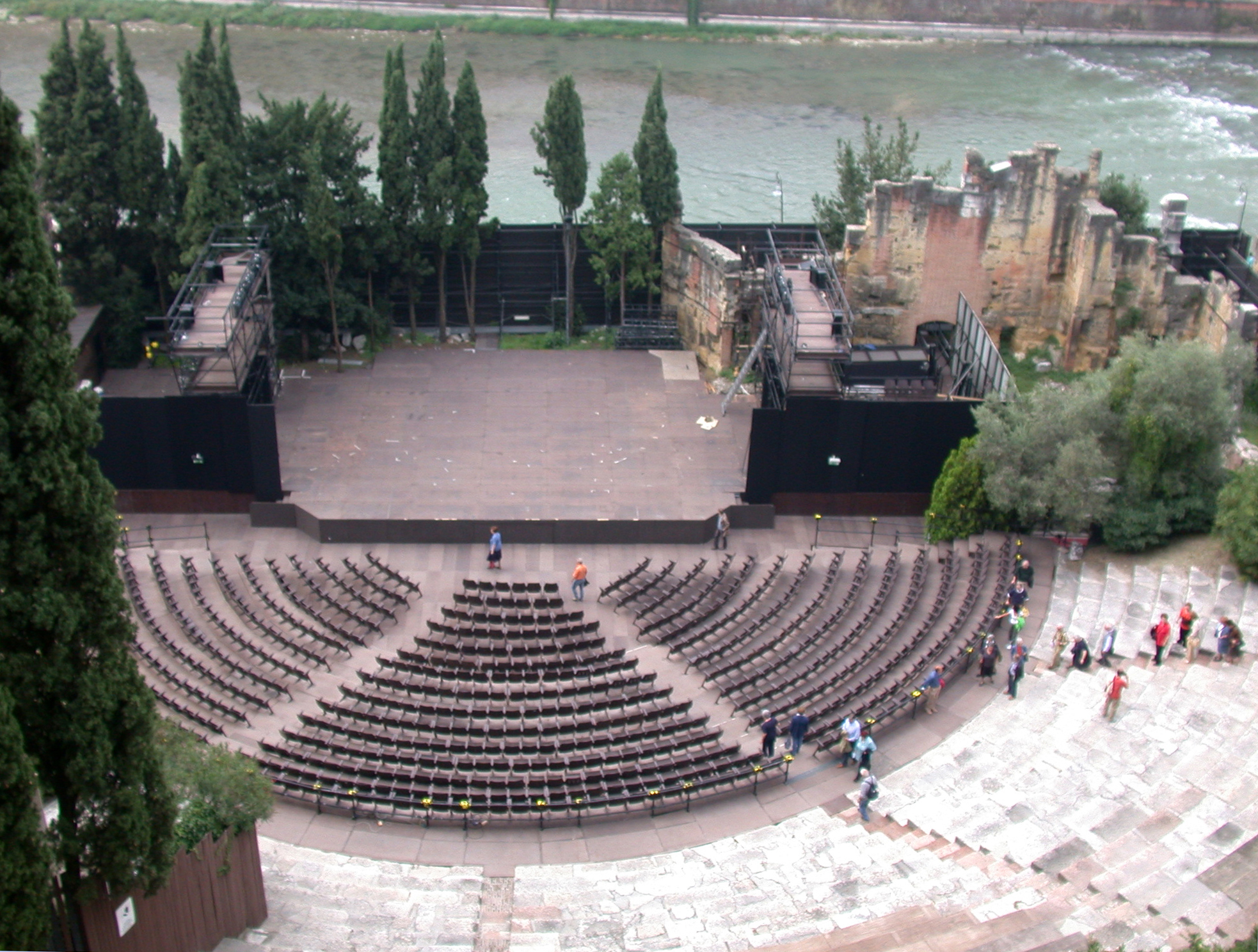
You must be logged in to post a comment.